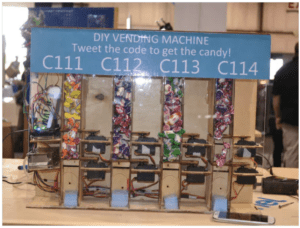Date: April 18, 2019
Instructor: Marcela
Our initial definition only considers how many factors we involved in the project and focus on the interaction triggered by a real behavior or action. And we confused the concept of function and interaction. During the learning process, I found interaction is not necessary with a function, in other words, function is a kind of interaction. We have discussed about the aim of interaction. Some projects help the disability to draw, some can improve the traditional communication way. Interaction is around us and it can be in any forms, the light and shadow, the sound and visual art. Interaction might bridge between computer and reality. Technology is a tool to achieve interaction, complicated and simple. But technology is not a standard to evaluate the interaction. Instead of chasing complicated technology, I think the feelings what the project can bring is the most important. When I have midterm projects, during the user test session, I received many helpful comments, including “increase visual equipment” “change the language showed in the computer”, which further evolves my understanding of “interaction”. I am aware that details can help a lot. Marclea also reminded me that we are not selling products but we are showing a new way of interaction. I start to reconsider the real meaning of our projects and interaction in reflection. Focus too much on the functions might limit our imaginations. Some projects look weird but really involves users, some projects look simple but advance the relationship between people and environments, different individuals. Up to now, after I see more art projects and learn more processing skills and communicate with fellows, my beliefs of interaction improves further.
The “Espongia”, created by Merche blasco, is a gestural controller using the water and wood to produce sound through interactions with audio software. This project inspires me that even very simple structure can create thrilling music. The music instrument is easy to operate and reflects the emotions of players leaving the audience great impressions. Though only with one waterproof sensor, the instrument can create thousands of tones through analyzing the vibration of the water. Instead of aim-orientated, this instrument fulfills the standards of my definition of interaction, simple but showing a new interaction way with the normal things in life, the wood, the water.
Another project inspires me is the Beetbox musical instrument. With strange appearance, it attracts me and makes me happy when I see the video. You never expect that this is a musical instrument. This project applies complicated technology but all technology is invisible. The interaction is extremely easy but gives abundant experience beyond expectation.
A work I think is not very interactive is the automatic DIY vending machine, it focuses too much on the functions of the project and its use in real life but ignores the interaction between the project and users. People cannot have strong change of emotions or feelings. It is not aligned with the standard of the interactions. It does save the time of customers and involves the interaction but it doesn’t bring strong emotional experience. Interaction is not inventing something useful but recreating the normal things and shifting our mind.

In combination, the understanding of these three projects makes me more clear about what interaction really is. My own definition of interaction is that human beings communicate closely and produce emotional connections with a project, which improves or changes the original way of communication between human themselves or human and environments. Interaction might be in any forms, visible or invisible, sound or light, complicated or simple, and it influences people’s perception of the environment and the relationships. It further helps people to build up dialogues and exploration between themselves and culture, history, philosophy, far beyond the limitations of physical materials.